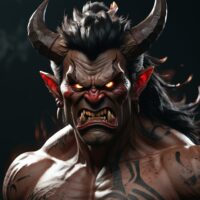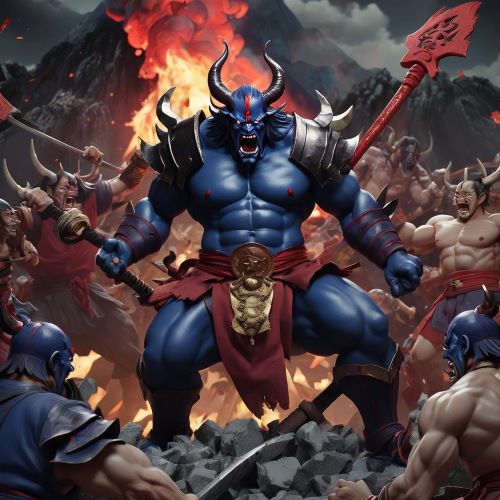Oni : The Demonic Spirit
Listen
At a glance
| Description | |
|---|---|
| Origin | Japanese Mythology |
| Classification | Spirits |
| Family Members | N/A |
| Region | Japan |
| Associated With | Evil, Bad Luck, Super Strength |
Oni
Introduction
Japanese mythology abounds with captivating creatures, ranging from benevolent to malevolent. Among the latter are the Oni, formidable ogres or demons deeply ingrained in Japanese folklore. With their terrifying visages and proclivity for chaos, Oni have entrenched themselves in Japanese culture, featuring prominently in folktales and contemporary media. Translating to “demon” or “ogre,” Oni are integral to Japanese folklore and mythology, often linked with malevolence and believed to inhabit caves or secluded mountainous regions. Possibly originating from China alongside Buddhism, Oni have captivated Japanese imaginations for generations, symbolizing both evil and a nuanced moral ethos. Their imposing presence and formidable abilities have cemented Oni not only as fixtures in traditional myth but also as enduring icons in modern culture, shaping Japan’s cultural landscape.
Physical Traits
Oni, typically towering over humans, boast various skin tones, often depicted in red, blue, or green hues reminiscent of dragons’ scales. Their formidable presence is accentuated by their horned heads, sharp fangs, and unruly hair obscuring their eyes. Clad minimally, if at all, in animal skin loincloths, they wield iron kanabō clubs with devastating force. Despite their monstrous appearance, Oni are not bound by a fixed form; legends suggest they possess shapeshifting abilities, allowing them to assume human or animal guises. These formidable beings, with their iconic horns and fearsome physiques, embody both the terror and awe of Japanese mythology.
Family
The origins of Oni in Japanese mythology remain veiled in mystery, with theories proposing a connection to the Chinese concept of “gui,” spirits of the deceased. Unlike their Chinese counterparts, Oni aren’t mere vengeful spirits; they’re depicted as corporeal beings inhabiting remote mountainous or subterranean realms. While predominantly male, Oni can be of either gender, with females occasionally known as Yamauba. They possess the ability to assume human guise regardless of their inherent gender. Though lacking a formal hierarchy, some tales depict Oni as familial units, as seen in the legend of Momotarō, featuring a red Oni with a spouse and offspring, hinting at a domestic dimension to these formidable entities. In Japanese lore, Oni are often depicted as solitary entities, wandering forests and mountains in pursuit of mischief and souls to torment. However, other narratives suggest a more complex social structure, with Oni kings and queens reigning over lesser kin, reminiscent of human power dynamics.
Other names
Though commonly known as “Oni,” these demonic entities assume diverse identities across Japan’s regions. Some regions dub them “Ogres,” highlighting their savage and monstrous traits, while others refer to them as “Namahage,” tying them to rituals purging evil spirits during New Year festivities. Yet, regardless of name, Oni maintain their feared and revered status throughout Japanese folklore. The term “Oni” itself is expansive, encompassing a wide array of demonic beings, each with distinct characteristics or regional affiliations. Among these variations are the “Yama oni,” associated with the underworld, serving as guardians or tormentors of the deceased, and the infamous “Shuten Dōji,” a powerful bandit leader in folktales.
In addition, there’s the “Onibaba,” or “demon hag,” depicted as an elderly woman luring unsuspecting travelers to their demise. Beyond “Oni,” these entities are classified as yōkai, a term encompassing various supernatural beings in Japanese folklore. Depending on context, they may also be likened to demons, orcs, ogres, or trolls, illustrating the breadth of their presence and impact within Japanese cultural narratives.
Powers and Abilities
Oni are renowned for their extraordinary physical prowess and supernatural abilities. Their shapeshifting prowess enables them to effortlessly deceive and ensnare their prey. Moreover, they command the elements, capable of summoning tempests and seismic upheavals at will. Particularly chilling is their penchant for consuming human souls, drawing sustenance from the fear and anguish of their victims to perpetuate their own existence. With the ability to pulverize boulders and wield their kanabō with devastating might, Oni stand as formidable adversaries, demonstrating remarkable resilience in enduring considerable damage before succumbing.
Beyond sheer strength, Oni possess an array of otherworldly gifts. Some can breathe fire or manipulate natural forces, while their cunning and intelligence allow for the orchestration of elaborate schemes to sow chaos. However, despite their formidable nature, Oni are not impervious. Vulnerable to conventional weapons like swords, their fiery tempers serve as another Achilles’ heel, easily provoked into recklessness. Certain rituals and protective measures, often involving sacred objects or symbols, are believed to repel Oni and thwart their malevolent influence. Despite their ominous reputation, Oni have also been associated with bestowing prosperity and good fortune in certain folklore narratives.
Modern Day Influence
While Oni trace back to ancient mythology, their impact resonates strongly in contemporary Japanese culture. From literature and cinema to video games and manga, Oni persist as compelling figures, embodying both grandiosity and intricate morality. They symbolize the darkness inherent in humanity and the resilience required to confront it, transcending their mythological origins to retain a prominent role in modern Japan. Appearing in diverse mediums such as woodblock prints, paintings, and even traditional performances, Oni’s fearsome countenances adorn festival masks, notably during Setsubun, where they paradoxically serve as talismans to ward off malevolent spirits.
In modern media, Oni continue to hold sway as ubiquitous figures, featuring prominently in video games, films, and even children’s animations, often cast as adversaries or supernatural beings. While their depiction may veer from the terrifying portrayals of traditional folklore, they endure as recognizable symbols of the monstrous and otherworldly. Oni represent the inner darkness individuals must confront, serving as a potent reminder of life’s adversities and the imperative to embody strength, fortitude, and resilience. Their enduring presence underscores their profound influence on contemporary Japanese culture, permeating literature, performing arts, and visual mediums alike.
Related Images
Frequently Asked Questions
What is lorem Ipsum?
I am text block. Click edit button to change this text. Lorem ipsum dolor sit amet, consectetur adipiscing elit. Ut elit tellus, luctus nec ullamcorper mattis, pulvinar dapibus leo.
What is lorem Ipsum?
I am text block. Click edit button to change this text. Lorem ipsum dolor sit amet, consectetur adipiscing elit. Ut elit tellus, luctus nec ullamcorper mattis, pulvinar dapibus leo.
What is lorem Ipsum?
I am text block. Click edit button to change this text. Lorem ipsum dolor sit amet, consectetur adipiscing elit. Ut elit tellus, luctus nec ullamcorper mattis, pulvinar dapibus leo.
What is lorem Ipsum?
I am text block. Click edit button to change this text. Lorem ipsum dolor sit amet, consectetur adipiscing elit. Ut elit tellus, luctus nec ullamcorper mattis, pulvinar dapibus leo.
What is lorem Ipsum?
I am text block. Click edit button to change this text. Lorem ipsum dolor sit amet, consectetur adipiscing elit. Ut elit tellus, luctus nec ullamcorper mattis, pulvinar dapibus leo.









